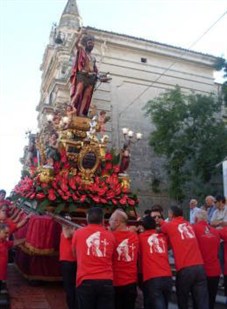A conflicting religiosity
A significant aspect of Sicilian religiosity between the sixteenth and seventeenth centuries was the strong conflictuality within Religious Orders, secular clergy, confraternities and churches.
 This conflictuality displayed itself with particular virulence during religious ceremonies, inside churches but above all during celebrations for feast days, processions and external rites. It was a kind of “war of saints”, which Giovanni Verga narrated in one of his short stories. (photo 1, Celebrations for the feast of Saint George at Modica; photo 2, Celebrations for the feast of Saint John at Ragusa).
This conflictuality displayed itself with particular virulence during religious ceremonies, inside churches but above all during celebrations for feast days, processions and external rites. It was a kind of “war of saints”, which Giovanni Verga narrated in one of his short stories. (photo 1, Celebrations for the feast of Saint George at Modica; photo 2, Celebrations for the feast of Saint John at Ragusa).
The phenomenon was particularly evident in the diocese of Syracuse, which, in 1774, Bishop Alagona defined a “diocese of discord” and writing to the king he noted: “every town, however small, is divided into two or three factions which, in whatever religious function which they must perform inside their church or procession outside of it and for whatever other reason which they call jurisdictional, they often come to blows or they do harm to the reputation of the church in various fights, foment enmities and hatred among close family members and in sacred courtyards. Scandals are on the increase and they cease to distinguish between the sacred and the profane, breaking out into heretical blasphemy on acount of devotion.”
 An explanation can be found in the earthquake of 1693 which made conflicts rise to the fore which had been latent until then. The cities, almost completely destroyed, very often were “divided” and they were reconstructed with a new spatial division: aristocratic and popular classes who began to demand a greater political role, settled in two different parts of the city, one “high” and another “low” and each had their respective church, saint, rites and celebratory feasts. The reason for this was above all disputes on account of the ecclesiastical dignity which each church attributed to itself and the choice of a patron saint for the entire city.
An explanation can be found in the earthquake of 1693 which made conflicts rise to the fore which had been latent until then. The cities, almost completely destroyed, very often were “divided” and they were reconstructed with a new spatial division: aristocratic and popular classes who began to demand a greater political role, settled in two different parts of the city, one “high” and another “low” and each had their respective church, saint, rites and celebratory feasts. The reason for this was above all disputes on account of the ecclesiastical dignity which each church attributed to itself and the choice of a patron saint for the entire city.
The proposed itinerary reaches some of the cities of southeastern Sicily which were destroyed then reconstructed after the earthquake of 1693 and where conflict was more acute between churches, saints and the faithful and where there are still grandiose Baroque ceremonies in favour of two “patron” saints, where the competition between the two principal churches was transformed into a component of the rite, depriving it of the original element of social and political conflict within the community.
